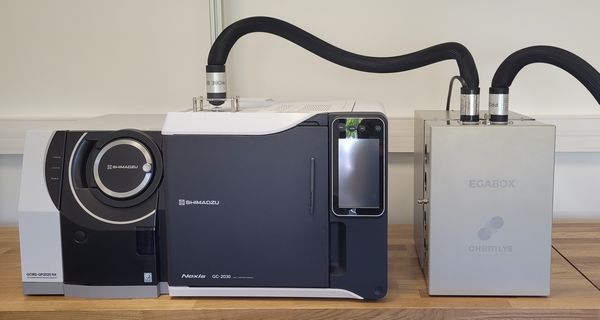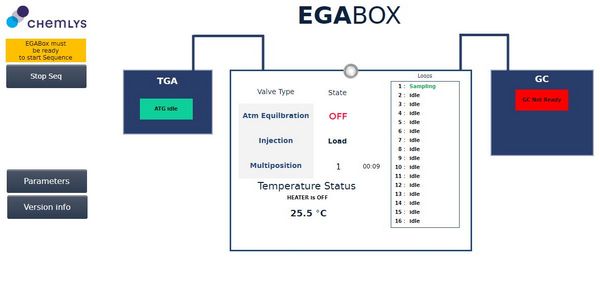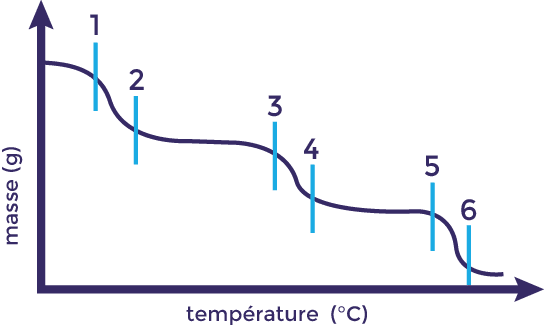EGA analysis: EGABOX coupled with a GCMS-QP2020 NX Shimadzu

Thanks to the EGABOX, carry out detailed qualitative and quantitative analysis of your EGA in GC/MS.
Up to 16 evolved gas fractions collected during TGA cycle
Obtain detailed information on your gases emitted during your entire TGA cycle, even in the case of fast kinetics.
Complete GC/MS analysis of each sample collected during TGA cycle.
GC/MS analysis allows you to obtain complete qualitative and quantitative information for each sample collected. Access to NIST database for identification of unknown compounds.
EGABOX features:
- 16 samples of evolved gases collected during TGA cycle
- Sampling and storage heated (200°C) without any cold spot
- Fully automated, web based software, license-free
- Compatible for sample in hydrogen, inlet for inert purge gas
- Compatible with every TGA or GC/MS models
- Atmospheric pressure option and inert version
- Automatic purge cycle
- Compatible with FTIR, MS coupling
EGA analysis applications:
- Comparative studies of materials
- Analysis of non-conformities and understanding of a process defect
- Analysis of VOC emitted by a material
- Characterization of an innovative material
- Study of the release of gaseous compounds trapped according to the temperature
EGABOX, a new source of information on your complex samples.
Thermogravimetric analysis, or TGA, is a common technique allowing the characterization of physico-chemical parameters in the field of polymers and materials. The TGA results is a curve of the mass loss of a sample as a function of the temperature. This mass loss often generates evolved gases, or EGA, whose composition can be more or less complex.
When the mass loss is characterized by dehydration, the emission of simple light compounds such as hydrogen, carbon dioxide, etc., coupling with a Micro GC, an FTIR or an online MS is generally sufficient and has the advantage of a short analysis time (< 1 minute). You can see our application note on this topic for illustration.
When the evolved gases are of more complex composition with a large number of molecules, these analysis techniques have limitations. In this case, the alternative choice is coupling with a gas phase chromatograph coupled with a mass spectrometer (GC/MS).
Indeed, the coupling with a GC/MS makes it possible to provide detailed qualitative and quantitative information on all the molecules emitted. Mass spectrometry also allows the formal identification of the molecules detected, which proves to be a remarkable aid when the EGA is very complex or when the information on the sample studied is limited.
However, a GC/MS analysis is long, between 30 minutes and 1 hour! Much too long for a direct coupling with a TGA for the analysis of the evolved gases. The EGABOX developed by CHEMLYS makes it possible to sample up to 16 fractions of gas emitted during interesting mass loss times selected by the user. Thus, you are no longer limited by the analysis time of your GC/MS and you can obtain molecular information of your evolved gases over your entire TGA cycle.
Quick installation, multi-brand compatibility
Compatible with all TGA and GC/MS models and manufacturers, no additional software installation.
Easy to use, give a complete information
Simply fill in the chosen storage times, obtain complete molecular information of your evolved gases.
Proven performances
Inter-loop repeatability better than 1%, sample pressure management option, inert coating treatment option
Software directly accessible
without installation and license-free
Access the software simply by entering the IP address of your EGABOX in a browser and create the sequence of evolved gas sampling times. Launch your TGA to start your entire coupling*.
*the complete automation may depends on individual instrument specifications


Start a TGA cycle to determine the storage times of interest
then start your entire coupling to obtain full information.
You will get a detailed analysis with a chromatogram and the associated mass spectrum for each evolved gas sample taken and stored by the EGABOX.
With the NIST mass spectra library, identify all the molecular compounds in your evolved gas for each sample.
